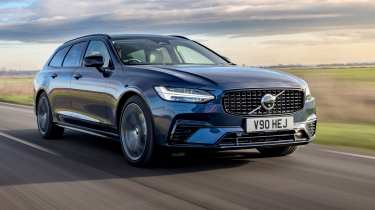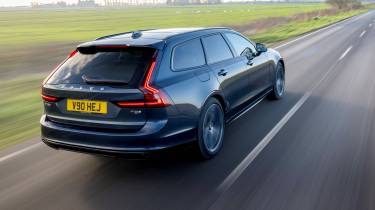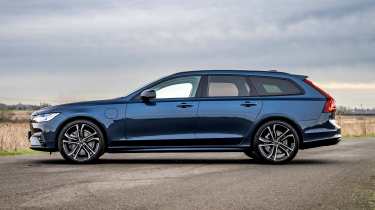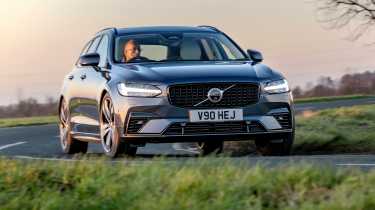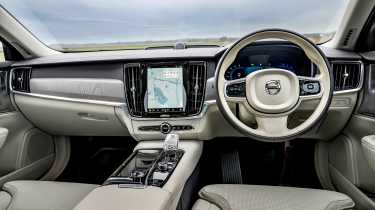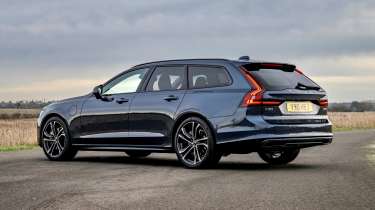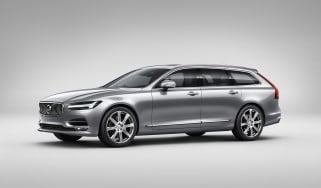Volvo V90 (2016 - 2025) review – Gothenburg’s answer to the Audi A6 estate is dead
The estate market shrinks again with Volvo’s flagship V90 receiving the axe. It was never the driver’s choice, but its maturity made it unlike most cars on the market today
Almost a decade since production began the Volvo V90 has met its end, with the final example rolling off the firm’s Torslanda production line in late-2025. While the death of yet another estate car isn’t something we like to see, there’s no hiding the fact this car is not one celebrated for its dynamic finesse. In its final and most potent form though, there’s still plenty to like about the V90’s no-nonsense approach.
Tackling a tricky b-road is not what Volvo’s largest estate car was ever designed to do, with everyday useability, class-leading safety and an ability to cover miles with ease being far higher priorities. This is one of few new cars that remains confident in its initial purpose, making no effort to be something other than what it really is.
> BMW M3 Touring review – the best fast estate gets even better
Engine, gearbox and 0-62mph time
Despite being a full-size estate, all V90s come with four-cylinder engines, with the lineup spanning from the sub-200bhp B4 to the 296bhp B6 AWD and the range-topping 449bhp plug-in hybrid T8 AWD we have here. This is not just something limited to the V90, with Volvo’s entire range converted to four cylinder power in 2013.
An output of 449bhp makes this one of the most powerful Volvos with a combustion engine, but it does reach this power figure with help from electric motors – the engine produces a healthy 310bhp thanks to both turbocharging and supercharging, with the electric motor adding an additional 145bhp. Perhaps more important is the torque figure, because while the engine only manages 228lb ft, the electric motor contributes another 295lb ft to give it an impressive 523lb ft peak.
The point of using both a turbo and supercharger is to meter out the performance these two forced induction components provide. The supercharger is therefore a very small unit, essentially torque-filling the low end of the rev range (and initial throttle input) before the much larger turbo takes over, once its lungs have been filled by the subsequent exhaust gases. This doesn’t mean the T8 makes JDM-style noises though, with engine sound virtually non-existent in most scenarios.
The engine is connected to an eight-speed automatic transmission, and while this was a sore point in previous V90s, it’s well sorted here in the T8. Interestingly there are no paddles behind the steering wheel whatsoever, with a tachometer also not part of the standard digital dash layout – you never feel the need for either, with the transmission picking the right ratios for just about everything you ask of it.
Even with zero battery range the T8’s powertrain is very effective, with plenty of instantaneous torque at your disposal for effortless progress. Unlike some highly tuned four cylinder engines, this one doesn’t tirelessly hunt around to find power, instead remaining calm and (seemingly) understressed. A distinct lack of drive modes also makes it a wonderfully easy car to understand, feeling confident in its standard setup.
The 0-62mph sprint in range-topping T8 AWD PHEV-form stands at 4.8sec, seven tenths ahead of the T6 AWD and 1.4 seconds quicker than the B6 AWD that came before it – while top speed for all Volvo models is capped at 112mph. In electric-only mode, Volvo says you can expect a range of around 50 miles WLTP combined from its 18.8kWh (14.7kWh usable) battery pack, positioned in the transmission tunnel. Unlike some hybrids, the V90 can return reasonable efficiency with the battery empty, as we saw in the region of 40mpg.
Ride and handling
No matter the form it comes in, with or without the ‘Polestar optimisation package’, the V90 doesn’t encourage brisk driving. It’s immediately clear that even in T8-form, this is not a car that’s keen to push on, being softly sprung and isolating you from the road. What this does give the V90 is an ability to waft like nothing else in its class, with roads of a reasonable quality allowing for a supremely relaxing driving experience.
Pile on the pace on a more challenging road though, and a lack of body control means it can all come undone quite quickly – at 2075kg, perhaps this shouldn’t come as much of a surprise. Models further down the range weren’t known for a sophisticated low-speed ride thanks to a lack of wheel control, something exaggerated by larger wheel sizes and lack of tyre profile.
The steering setup leans into its preference for wafting, with its slow rack seemingly geared for comfortable motorway cruising rather than tight British b-roads. It does do this very well though, making the V90 a pleasant way to cover long distances, but in town it can become a little tiresome especially given the rack’s lazy self-centering. A thin rim and its ultra-light weighting are nice to have in certain situations, but increase the pace and the lack of feedback knocks your confidence back a notch.
Interior and tech
The V90’s theme of maturity carries through to the interior, with a premium design that’s a step above its German alternatives. The light leather upholstery and open pore wood trim of our test car make for an airy, modern feel, and with none of the occasional cheap piano black plastic you get in just about everything else in this segment.
Aside from perhaps the crystal gear selector, it’s all very modest inside, with even the ambient lighting pared-back and limited to just a few tasteful shades in-keeping with the theme. The flat-top design of the dashboard is a nice touch, and everything is well screwed together – there were no squeaks or rattles in our experience, with touch points such as the ergonomic interior door handles reassuringly weighted. Wind and road noise are very minimal at all speeds and as a byproduct, this gives the sound system headroom for impressive performance.
It’s not perfect, though. Ride might be on the soft side, but the seats certainly aren’t. The Google-based UI of the central portrait infotainment system is also nice to have, but the hardware powering it all feels very last-generation, with no-so-sharp graphics and a lack of wireless Apple CarPlay – this is especially frustrating when climate controls are hidden behind menus within this system. There’s no doubt there are too few physical buttons in this cabin, but once you’re up and running with entertainment and navigation, the V90’s simplicity means you won’t need to change much else.
Oddly, despite the V90’s size, we also found interior storage to be lacking, even for a smartphone – the central storage cubby won’t suffice for this, as it’s laughably shallow due to the fitment of the battery pack within the space beneath. Thankfully the boot is of a good size (650 litres with the seats up), but the electronically retractable cover can occasionally get in the way when loading.
Price and rivals
In its final year on sale, the V90 range was distilled down to the £62,410 T6 plug-in hybrid and the £70,910 T8 PHEV we have here. Stack this up against its closest rivals from Germany and you'll find it came in at the higher end, with the likes of the Mercedes-Benz E-class estate and BMW 5-series touring starting from £59,720 and £54,535 respectively.
Given it's now off sale though, the used market will be the only place to find a V90 in not too long. Having been on the market since 2016, there are some very good deals to be had if you're willing to punt for an older example, with the cheapest six figure-mile cars on the market for sub-£10k – there are even T8s on the market for under £20,000 if you look hard enough. If you're not feeling quite so brave, a 2023 V90 with around 30,000 miles on the clock can be had for just shy of £30,000.
What to look out for
Unsurprisingly given Volvo's reputation, reliability is strong overall, but there are a few key things to keep an eye out for. The undercover police car look might ensure everyone around you abides strictly to the speed limit, but an ex-police V90 is probably one to avoid given the high (and hard) miles it will have endured. Keep a close eye on models with air suspension, as failure of this system can be pricey. Regular service intervals is also something to look out for as the complexity of the powertrains on offer makes proper maintenance key to trouble-free ownership. As with most cars, there have also been a number of recalls throughout its lifetime, so ensure the car you're looking at doesn't have any outstanding.
Volvo V90 (Ultra T8 AWD PHEV) specs
| Engine | 2-litre turbocharged four-cylinder + hybrid assist |
| Power | 449bhp |
| 0-62mph | 4.8sec |
| Top speed | 112mph |
| Electric range | c50 miles WLTP |
| Weight | 2075kg |
| Power-to-weight | 216bhp/ton |
